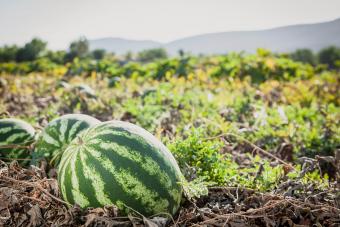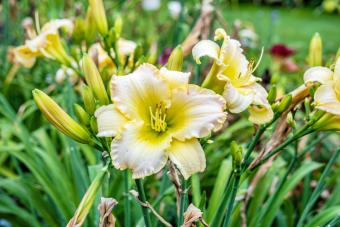
Watermelon is one of the most satisfying garden crops to grow, but it's not necessarily the easiest. Getting your plants to produce large, tasty fruit involves a little luck and a lot of attention to the unique needs of the plant. Follow this collection of the top tips for growing the best watermelons.
Planting Advice
Watermelons need fertile soil and a long, hot growing season to produce good fruit. One of the main reasons the fruit fails to become sweet and mature is because of lack of heat during the ripening period. Watermelons are an annual that can be grown in any zone during summer, but only in USDA zones 4 and warmer is there a long enough growing season for them to produce good quality fruit.
When to Plant
The right timing is very important when sowing watermelon seeds or planting transplants.
- Sow seeds indoors 6 to 8 weeks before the average date of last frost to get a head start on the growing season.
- Transplant the seedlings into 6-inch pots while they're still indoors so they can put on plenty of growth before they are planted in the ground.
- Wait to plant watermelon in the ground until after your last spring frost date, and once the soil has warmed. Nighttime temperatures should consistently be warmer than 50 degrees Fahrenheit.
Where to Plant
Only plant watermelons where they will receive at least 8 hours of sun per day. In climates where summers are short and cool, plant watermelon against a south-facing wall for extra warmth.
Planting where the watermelon vine can sprawl onto a concrete patio will give it extra warmth.
How to Prepare the Soil and Plant
Proper soil and site preparation will get your watermelon off to a healthy start. Before planting, make sure the area is clear of all grass and weeds, which would compete with the watermelon plants for water and nutrients.
- Mix compost with the planting soil at a 1 to 3 ratio and form into hills about 12 inches tall to create the rich, loose soil that watermelons love.
- Space the hills about 6 feet apart and plant three to four seedlings on each so they have plenty of room to grow.
- Cover the soil around the seedlings with black plastic -- this holds the heat in, prevents weeds from growing and keeps the fruit from developing soil borne diseases.

Growing Watermelons in Containers
While watermelons definitely have a reputation for sprawling, there are a few varieties that are wonderful for small space gardeners and gardeners who want to grow watermelons in containers. There are a few things to keep in mind when growing in containers, but this is definitely a viable option; any gardener can grow watermelons regardless of how much or how little space they have.
Best Watermelon Varieties to Grow in Containers
While you could technically grow any watermelon variety in a container, you'll have much more success if you choose a bush-type variety that is bred for container culture.
- 'Sugar Baby' is a bush variety that produces fruits that are seven to eight inches across, with deep pink flesh and dark green rinds.
- 'Sugar Pot' is a vining watermelon variety that produces two to three eight-pound fruits per vine.
- 'Mini Love' has small, "personal-sized" watermelons that grow on compact vines and have deep red flesh and striped green rinds.
Choosing a Container for Growing Watermelons
You can grow watermelons in everything from a grow bag to a galvanized tub or a large plastic pot. Much more important than the material is the size.
Watermelons are best grown in containers no less than 18 inches deep, and at least 18 to 24 inches across. If you're growing more than one watermelon per pot, then the container will need to be even larger than that.
It's also important to make sure that whatever container you're growing in has drainage holes; if it doesn't, you'll want to drill a few into the bottom before planting your watermelons.
Tips for Growing Watermelons in Containers
The wonderful thing about growing in containers is that it's so flexible, and there are many ways to take advantage of that flexibility.
- Place your container wherever your watermelons will grow best. A spot that gets at least eight hours of sun per day is ideal, and if you can place it on brick or concrete, even better, because the soil will soak up all of that heat and the plants will love it.
- Watering regularly is important when growing melons in general, but you'll want to be even more careful about it when growing in containers; in very hot weather, the soil can dry out quickly, so containers will need to be monitored more closely.
- Fertilize container-grown watermelons every two to three weeks with balanced fertilizer, fish emulsion, or kelp meal. A light topdressing of compost is also a good idea.
- If you're very tight on space, you can grow container-grown watermelons up a trellis. Either attach a trellis to a wall nearby or stick it deep into the pot. Train the vines up the trellis as it grows, and support the forming fruits with netting or old pieces of nylon.
General Watermelon Care Tips
Insufficient water is one of the primary reasons that watermelon plants fail to thrive. You'll also need to pay attention to pests and disease and may want to do a bit of pruning to encourage optimal fruit production.
Water
Watermelons, like most fruits and vegetables, are mostly water, so watering properly is a vital part of growing healthy, sweet watermelons.
- Watermelons should be watered whenever the top inch of soil dries out - they may need up to 2 inches of water per week during hot weather.
- Leave a hose to trickle at the peak of the planting mound to make sure the water actually gets to the roots and doesn't run off.
- For the sweetest flavor, reduce watering as the fruit gets bigger - at the very end, the vines can be allowed to dry out to the point where they are slightly wilted.

Fertilizing
Watermelons are fairly heavy feeders and will need regular fertilizing throughout the growing season.
- For lush growth, fertilize with a high nitrogen fertilizer up until the flowers and fruit begin to form, such as 10-20-10.
- After the fruit develops, switch to a high phosphorus fertilizer, such as 20-10-10, to encourage large, healthy fruit.
Watermelon Pests and Diseases
There are a few pest and disease issues to look out for when growing watermelons.
- Do not plant watermelons in beds where fusarium wilt or other diseases of the watermelon family have been a problem; this includes diseases of squashes, cucumbers, gourds, and other melons.
- Avoid watering the leaves of the plant to help prevent foliar disease -- water at ground level only.
- Inspect the base of the vine regularly for small holes where squash vine borers have tunneled. They are serious pests and often require treatment with insecticides to cure.
- Mild, not-toxic insecticides, such as insecticidal soap, are sufficient to cure most other watermelon pests, which include aphids and other sucking insects.
A Few More Watermelon Growing Tips
Here are some additional tips for watermelon success.
- Watermelons are reliant on bees for pollination, so avoid using pesticides and take steps to attract them; this includes planting flowering herbaceous species nearby, such as clover and lavender.
- Remove lateral vines that emerge from the main stem to increase the size of the fruit.
- For the biggest fruit, pinch off most of the flowers to allow only two or three fruits to form per plant.
- If black plastic mulch is not used, slide a piece of cardboard, a wooden plank, or a handful of straw under the fruit to lift it off the soil -- this keeps the fruit from rotting.
Helpful Harvest Information
Watermelons do not ripen off the vine, so it's important to learn how to pick them at the peak of maturity.
- Ripe fruit makes a hollow sound when you thump it with a finger.
- The part of the melon facing the ground turns from white to a cream color when the fruit is ripe.
- Ripe fruit should give a bit when you press into it.
- If the vine is fully green, the fruit is probably not fully ripe -- wait to pick it until the vine has started to shrivel up a bit.
- Use a knife or hand pruners to clip the vine from the stem, leaving a little piece of stem attached.
Watermelon Varieties for Your Garden
Some watermelon varieties are better suited to certain situations than others. A few examples of common cultivars and the best situations to use them in include:
- 'Golden Midget' - Bears very small (3-pound) fruit with yellow skin; ripens in a short season, so it's one of the best for northern gardeners
- 'Smile' - A medium-sized melon with a thin rind; one of the sweetest varieties available
- 'Sangria' - An extra large, oblong melon with red flesh; one of the largest of all watermelons (up to 15 pounds or more), but needs an extra long hot growing season to become sweet
Sweet and Satisfying
If you've tried growing watermelons before, but haven't had much luck, try some of the time-tested tips mentioned here. With a little extra TLC, you'll have the perfect watermelons you've been dreaming of.







